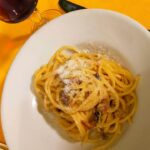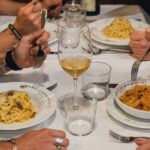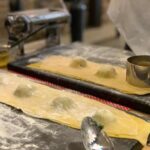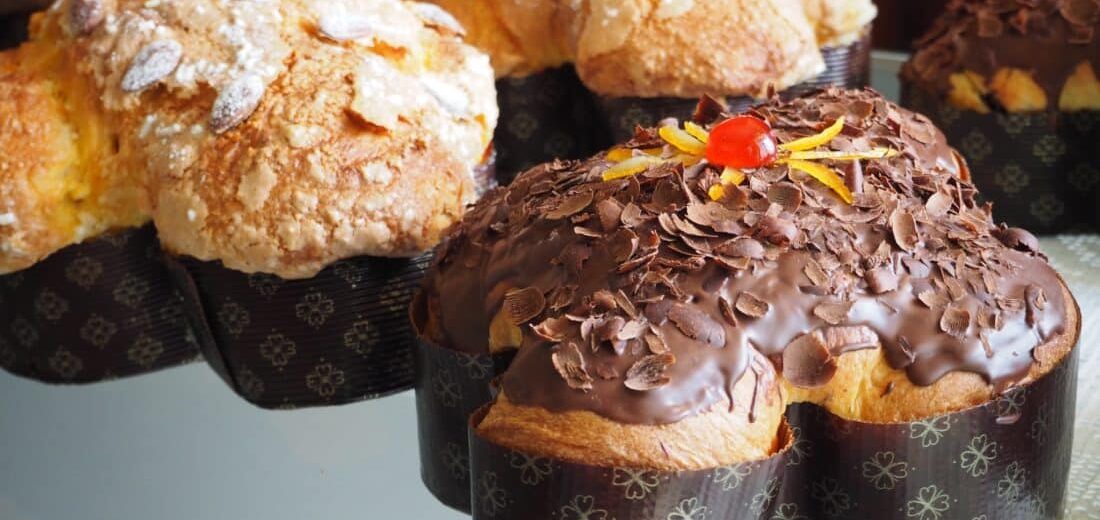
Easter Food in Italy
Wondering what is the typical Easter food in Italy? Without doubt Italy is synonymous with food and it plays an important part in the Easter celebrations. While traditional food associated with the festive holiday includes fish, chocolate, lamb and eggs, there are many regional and specialty dishes that Italians eat for Easter (Pasqua in Italian).
While the Romans may enjoy abbacchio alla romana (baby lamb cooked with anchovies), the Pugliese eat pasta cooked with artichokes and almonds, whereas in Venice risotto with asparagus is a traditional dish, Easter food in Italy is diverse and plentiful.
Here are the traditional Easter dishes from antipasti to dolci, you’ll find on the Italian dining table from Good Friday to Pasquetta (Little Easter).
Table on Contents
- What do Italians eat for Easter
- Italian Easter food traditions
- The relevance of the egg and the lamb at Easter
What do the Italians eat for Easter?
As incredible as it sounds for a Country where breakfast is always consumed, if consumed, in a quick couple of minutes and sometimes it only consists of one espresso, the holiest Sunday of the year is a day when Italians can actually take it slow.
Boiled eggs, Easter bread, casatiello, torta al formaggio, torta pasqualina, colombo cake and chocolate eggs are usually offered for breakfast on Easter in Italy.
A typical Italian Easter dinner will often include soup, salad, risotto, pasta and lamb, served with veggies and plenty of wine.
Don’t forget to drink your coffee at the end, or you’ll fall asleep. And then, enjoy the ammazza caffè (literally ‘the coffee killer’), liquor like grappa or amaro, to help the digestion. Oh yes, you’ll need it.
Traditional Easter Food in Italy
1. CAKES
COLOMBA DI PASQUA
Colombra is the iconic culinary symbol of Easter in Italy. The must-eat Italian Easter cake (the equivalent of the Christmas panettone and pandoro), originates from Milan and is usually consumed for breakfast or an afternoon snack.
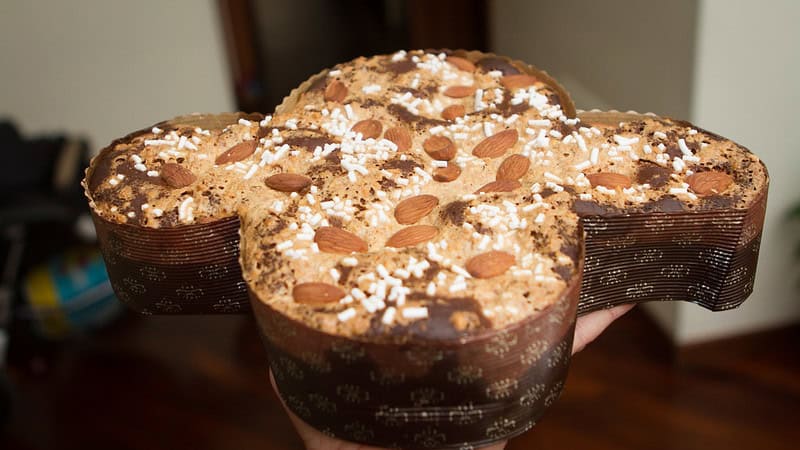
The sweet yeast bread with eggs in the dough is filled with candied fruits or chocolate, often with almonds and sprinkled sugar on top. It is made in the shape of a dove (hence the name colomba), the Christian symbol of peace and salvation.
Rather than making homemade, most Italians buy Colomba from a bakery. Here is a recipe to if you wish to try at home.
PASTIERA NAPOLETANA
Pastiera Napoletana is a popular Italian Easter dessert created in a convent in Naples, inspired by the flowers growing in the spring garden.
It consists of cookedwheat berries (symbolizing fertility), ricotta, eggs, lemon zest, candied orange peel, orange flower waterand spices.
The recommended preparation process is to start making the dessert on Good Friday, to allow the flavors to infuse and maximize in flavor before Easter Sunday.
TORTA AL FORMAGGIO
Torta al Formaggio, also known as pizza di Pasqua comes from the Umbria region and is usually what Italians eat for breakfast on Easter.
This savory cake is made with eggs, flour, grated pecorino and parmigiano cheese, yeast, oil and milk. It is shaped like a dome, similar to the panettone Christmas cake.
L’AGNELLO PASQUALE
L’agnello pasquale is a rich sweet cake originating from Sicily, made with almonds from Castrofilippo and pistachio from Bronte.
SCHIACCIATA
Schiacciata is a Florentine Easter cake, filled with cream and topped with orange zest.
2. ITALIAN EASTER BREAD
TORTA PASQUALINA
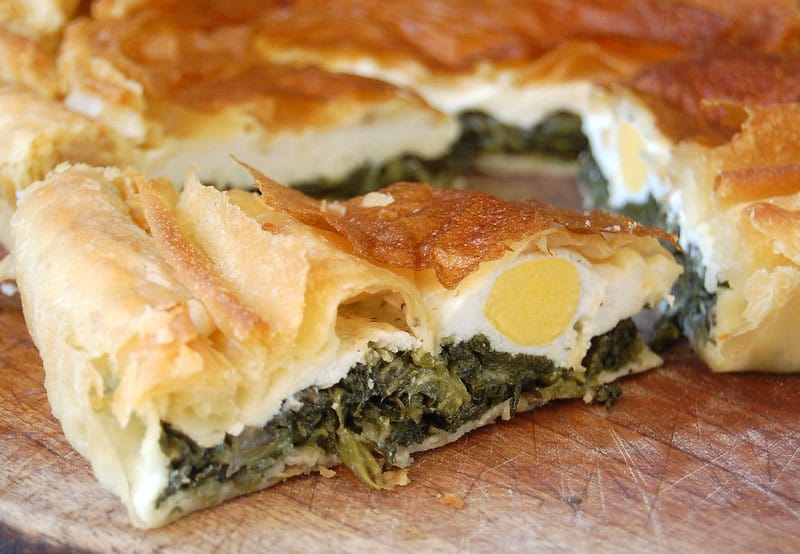
Torta Pasqualina. Photo credit Giulia Robert
A puff pastry pie originating from Genova, traditionally made with 33 layers, to symbolize the years of Jesus. It is stuffed with hard-boiled eggs, bietole (green beets) or artichokes, prescinseua (an acidic soft cheese from Liguria) and marjoram.
CASATIELLO
Created in Naples, Casatiello is one of the most famous Italian Easter foods. It’s a ring-shaped bread filled with boiled eggs, pancetta, salami and cheeses, such as provolone, Parmigiano Reggiano and pecorino.
PRINZA TRIESTINA
Soft sweet bread similar to a brioche, made with orange and lemon zest. It originates from the northeast Italian region of Friuli Venezia Giulia, usually served for breakfast with salami and cheese.
The three incisions on the loaf form a Y that symbolizes the martyrdom of Christ.
CRESCIA DI PASQUA VALDOSTANO
Crescia di Pasqua Valdostano is bread from the Valle d’Aosta Alpine region, made with aged cheese and extra egg whites, resulting in a soft and fluffy texture.
PAN DI RAMERINO
Pan di ramerino is a Tuscan Easter bread made with raisons, walnuts and rosemary.
Our content is funded by our award winning food tours in Rome, which are top-rated on all the review platforms. Take a look at our website so see our food tours and cooking classes.
3. LAMB DISHES
When it comes to cooking lamb, usually roasted, different regions like to make it many different ways.
COSCIOTTO AL FORNO
Roasted lamb with potatoes, often served with peas or asparagus, popular in the northern regions including Veneto, Piemonte and Friuli Venezia Giulia.
Barolo, Amarone and Agliano del Vulture, are favorable wines to pair with this dish.
ABBRACCHIO ALLA ROMANA
In Lazio there are three popular lamb based Easter dishes. Abbacchio alla romana, is baby lamb cooked in white wine, with anchovies, garlic and rosemary.
CORATELLA
Coratellauses every part of the animal including the lamb’s heart, lungs and liver. It’s oven cooked with white wine, lemon juice, extra virgin olive oil, broth, salt and pepper, often served with artichokes.
ABBACCHIO A SCOTTADITO
Grilled marinated lamb cutlets, sometimes barbecued to add extra crispiness.
The Lazio dishes pair well with a light, low tannin red wine for example Magone made from Pinot Nero grapes, alternatively a smooth white wine such as Florano bianco.
POLPETTINE PASQUALI
Polpettine pasquali are Easter meatballs made with lamb meat, served in the Trentino region.
IMPANATA RAGUSANA
An ancient Sicilian recipe using a pork or turkey based pie, cooked with tomatoes and red wine.
BRODETTO PASQUALE
Brodetto pasquale is a dish originating from Bari incorporating lamb, eggs and peas or asparagus.
CUTTURIDD
Cutturidd also from the Basilicata region, is a lamb stew with potatoes, carrots, chicory, mushrooms and tomatoes.
Aglianico del Vulture is a dry red wine produced in the heart of Basilicata, which would suit these dishes well.
AGNELLO AL TARTUFO
Lamb cooked with truffles, is a popular dish in the regions of Tuscany and Umbria.
Chianti, Brunello di Montalcino and Vino Nobile di Montepulciano pair well with this dish.
CORDULA
A traditional Sardinian dish popular for Easter and Christmas, comprising of lamb intestines and guts weaved into a braid.
L’ARISTA DI MAIALE
A specialty dish from Tuscany. However instead of lamb, it’s made with pork loin, filled with herbs and beaten lard, served with potatoes or beans
VEGANS AND VEGETARIANS
The number of vegetarians and vegans in Italy has grown steadily over the past decade, resulting in a decline in the sale and consumption of lamb over Easter.
An advertising campaign in 2017, with ex Italian Prime Minister Silvio Berlusconi adopting five baby lambs, further promoted a vegetarian diet.
4. PASTA
One of the most popular things Italians eat for Easter is of course pasta.
Easter pasta dishes are diverse and vary from the north to the south of Italy, including lasagna, ravioli, risotto and baked pasta.
In the Emilia-Romagna region lasagna filled with lamb is the preferred choice. Alternatively lasagna with spinach is a vegetarian option.
Southern Italians enjoy lasagna filled with pork, tomato sauce, ricotta and hard-boiled eggs.
Culurgiones is a dish served in Sardinia, consisting of ravioli filled with potatoes and pecorino cheese, garlic, mint and nutmeg
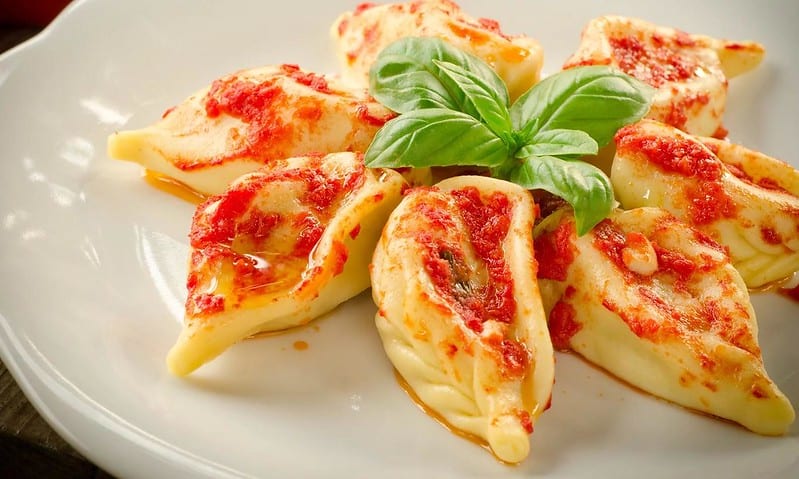
Also from Sardinia is Pillus (similar to tagliolini) cooked in beef broth.
Orecchiette pasta cooked with artichokes and almonds, is the traditional dish enjoyed by the Pugliese.
Another typical recipe from Puglia is Tiella, a casserole made from rice, muscles and potatoes.
In the Veneto region, risotto cooked with asparagus is the go-to-dish.
In Piemonte, Agnolotti del Plin is fresh pasta mixed with pork, veal, rabbit, spinach and Parmesan is a traditional dish.
5. SOUP
MINESTRA MARITATA
An Italian Easter meal might start with a soup such as Minestra Maritata, commonly made in Campania and Lazio.
Ingredients tend to include meat, vegetables and pasta.
SCIUSCEDDU
Sciusceddu is a Sicilian soup made with eggs, meatballs, cheese and herbs.
Other typical Easter starters include arancini from Sicily, also fried artichokes and suppli (fried rice balls) from Lazio
6. SALADS
INSALATA PASQUALINA
This Italian Easter salad from the Veneto region, is made with asparagus, shrimp tails, hard-boiled eggs, quail eggs, olives and extra virgin olive oil.
INSALATA BUONA PASQUA
In the Molise region, the Easter salad includes green beans, boiled eggs, tomatoes, strawberries and mango pieces.
7. EGGS
BOILED EGGS
Traditionally ladies bought eggs to church in order for the priest to bless them. This practice is still in use in some Italian villages nowadays.
Blessed or not, dozens of boiled eggs will be at the center of most dining tables in Italy on Easter day, for everybody to grasp one or two.
EGG DISHES
Usually they are served next to a big tray of cured meats, such as salami, soppressata, corallina, capocollo, prosciutto crudo, lonza and pancetta.
8. CHOCOLATE EGGS
Surely the most loved Easter food in Italy amongst children, but adults don’t dislike them either. They are often filled with small toys and fun surprises.
9. SPRING VEGETABLES
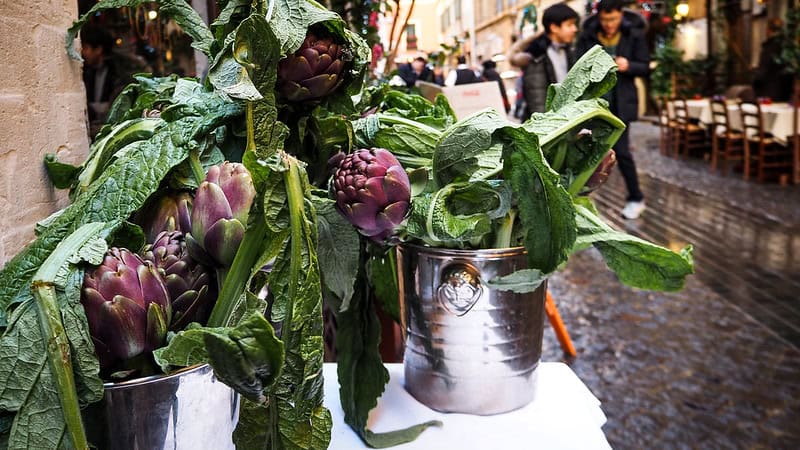
Seasonal vegetables are often found on the Italian dining table on Easter, offered as a side dish or an appetizer. Artichokes are a favorite choice, prepared in various methods.
Lazio is the home of artichoke cultivation, where they can be served braised in a carciofi alla Romana style, or fried Carciofi alla guidia version.
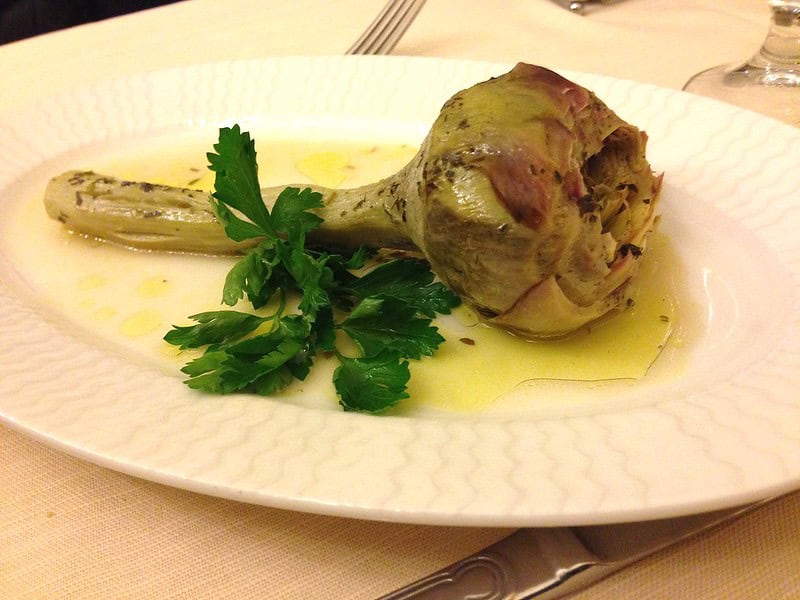
Alternative options include the Sicilian recipe Ammuddicati’ Alla siciliana, artichokes stuffed with breadcrumbs, or stuffed with pecorino, parmesan and pancetta, a typical dish from Abruzzo.
Asparagus, chicory and peas are other popular vegetable choices.
10. FISH
According to Christianity, Good Friday represents the day Jesus Christ sacrificed his flesh. Therefore Christians refrain from eating meat on this day.
The Italian good Friday menu consists of fish dishes ranging from soups, pasta and specialty dishes.
Sardines are a popular ingredient used in Sardinia with pasta, also in the Venetian region where they are marinated with onions, vinegar and wine.
Cuttlefish with beans, peas and potatoes is a popular recipe from Puglia.
In Marche clams with chickpeas is a traditional dish.
Fish soups are enjoyed in places close to the sea, also eaten with rice and polenta in the north Adriatic regions.
Italian Easter food traditions
In Italy there’s a saying: “Natale con i tuoi, Pasqua con chi vuoi!” (Christmas with your family, Easter with whomever you want!). But most Italians prefer to spend this holiday, with their family and their closest friends. Whether they’re religious or not, this two-day festivity will be spent, as to be expected, eating and drinking with the people they love.
The Holy Sunday is usually enjoyed indoors, while the Holy Monday – or the Monday of the Angels, which Italians call ‘Pasquetta’ (little Easter) – is often a good occasion for an outdoor gathering (scampagnata) with a picnic or a barbecue.
Inside or outside, the amount of food will be huge, because this is how Italians do it.
Also Easter comes after forty days of lent, when people who like to follow traditions undergo some sort of sacrifice, typically depriving themselves of certain types of food.
Not to mention the Good Friday, a day customarily spent in complete starvation.
Regardless if Italians are hungry on Easter Day and regardless where and with whom they spend the holidays, you can be sure there will be appetizing meals served throughout the country during the festive holiday.
The relevance of the egg and the lamb at Easter
As it often happens with food, most traditional dishes originate from ancient recipes. Usually these recipes are based on ingredients initially considered a symbol of the feast, something that would represent the deep meaning of the celebration. The two symbols of Easter are the egg and the lamb.
The egg, in ancient cultures, has always been seen as a representation of life itself. With Christianity, eventually this nutritious food, hidden inside a hard shell that looks like a stone, became an emblem of the resurrection of Jesus, metaphorically recalling the event of him coming out the sepulcher alive, leaving it empty as if no one was ever buried there.
Hence, there are many recipes based on eggs, where eggs are either in the mix or, even better, showed off in their holy wholeness!
The second symbol of Easter is lamb. It is a symbol used by Jews and Christians both: Moses and his people sacrificed a lamb to God the day before the exodus; Jesus, also called ‘the Lamb of God’, sacrificed himself on the cross.
Conclusion
Have I missed out any of your favorite Italian Easter dishes?
Leave them in the comments section below.
For more information email us or visit our Rome Travel Guide.
Please share this blog on social media if you enjoyed it.
